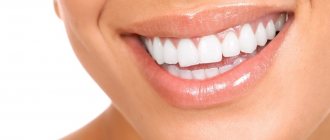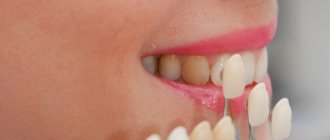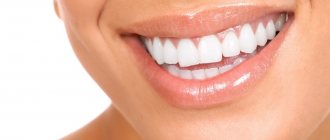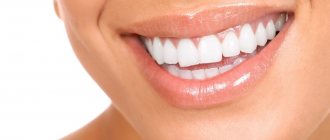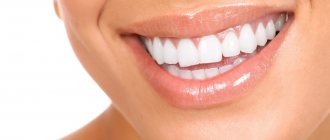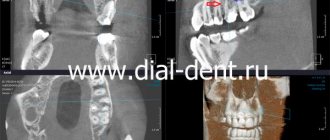How many canals are there in the teeth of the upper and lower jaws?
The main parts of the tooth are the crown (rising above the gum) and the root part.
Each tooth has its own shape and structural features. One of them is the number of roots and canals. The more a tooth has to withstand the load, the stronger it needs to “hold” in the gum. Therefore, it requires more roots. If you can figure out the number of roots of the teeth, then with the canals the situation is much more complicated. How many canals a tooth has has nothing to do with the number of roots. For example, the top “five” has only one root. At the same time, 75% of “fives” will have 1 channel, and 24% may have 2. In addition, there are another 1-2% of “fives” in whom the doctor detects 3 channels.
The root canal is the space inside the root . Complex anatomical branches can connect different channels to each other. At the tip of the horse there is an apical foramen. A feature of the tooth root system is that one hole can serve as an exit for several canals. Also, the channel sometimes bifurcates, ending in two exits. No two root systems are alike. Therefore, the doctor cannot do without an X-ray examination.
What are channels?
Each tooth has a certain number of roots located under the gum.
Read also: Dental mouthguard
How many roots do teeth have? The answer to this question depends on several factors - the position of the unit, the person’s age, heredity, even race. It is known that Mongoloids have more roots than Caucasians.
The standard quantity is as follows:
- Incisors, canines – 1.
- Premolars – 1-3.
- Upper molars – 3-4.
- Lower molars – 2.
- Third molars – 3-5.
Inside the crown is the pulp, a tissue consisting of blood vessels and nerve endings. They pass into the pulp through the apical foramen, located at the apex of the root, and through canals, narrow cavities inside the root. Their number is not always equal to the number of roots.
The photo shows the beginning of the root canals.
Why is there no accurate data on the number of canals in each specific tooth?
This situation is explained by the individual characteristics of the structure of each person’s teeth. Therefore, the dentist relies on statistical data and, if necessary, receives accurate information after appropriate research.
How do doctors figure out how many canals are in each specific tooth? A certain pattern does exist in this matter: the deeper a tooth is located in the mouth, the more complex its canal system is. This feature is due to the load that the tooth has to withstand.
In addition, statistics show that there are more canals in the upper teeth than in the lower ones, but not always. Therefore, it is possible to say about the exact number of canals only after opening the tooth or based on radiography. To preliminary determine the number of canals in teeth, statistical data are used, and to obtain accurate information, radiography results are used.
Why do you need to know about the number of channels? This question is very important during treatment and filling. If the doctor has not treated one of the canals, then an infection will remain in it, which will negate the result of the treatment.
Channels in baby teeth
There are as many nerves in baby teeth as there are in molars—one. In addition, temporary units are similar to permanent ones in the structure of the root system. That is, a milk tooth such as the upper six or second molar has a canal system similar to its molar brother, the second premolar.
Nerve endings perform standard functions:
- signal about developing caries;
- responsible for the growth and development of teeth;
- control the flow of water and nutrients to dentin and enamel.
The root canals of baby teeth are also treated and filled, but the tactics of their treatment depend on how long ago they erupted. Under the temporary units, permanent ones are formed, so treatment should be aimed at preserving them. Milk teeth can only be removed if the permanent teeth are ready to emerge.
The roots of permanent incisors, canines and molars do not form immediately, but over the course of about 3 years. Treatment of permanent teeth with unformed roots also differs from the standard one. The canals in the teeth of patients four, five, six years old (depending on the rate of formation of the dentoalveolar apparatus) are filled with a special paste with calcium and fluoride, which helps close the roots.
Accurate determination of the number of channels using an x-ray image
An x-ray allows you to determine exactly how many canals there are in a tooth. This method allows the doctor to see a complete picture of the condition of the teeth: the location of the roots, the presence of a cyst. The image helps to evaluate the quality of the filling performed, as well as to calculate how many canals there are in a particular tooth.
Some patients associate the word “X-ray” with something dangerous. However, modern devices do absolutely no harm to humans. The procedure does not require preliminary preparation; it is often carried out directly in the dentist’s office. The whole process takes no more than 5 minutes.
As a result of radiography, the doctor has a complete, and most importantly, clear picture of what is happening to the teeth. Where crowns or fillings are installed, white areas appear in the image, cavities appear black, and tissues and fluids acquire gray shades. The information obtained allows the doctor to determine the number of channels as accurately as possible and perform treatment while minimizing negative consequences.
Dental X-rays can be done even for nursing and pregnant women. Of course, there must be serious reasons for this, but in general the procedure is absolutely safe. The only unpleasant moment may be the appearance of a gag reflex. It occurs when the film is fixed to the gum. Deep breathing through the nose helps reduce the urge to vomit.
The images that can be obtained using x-rays are divided into two types:
- Orthopantogram - displays a complete picture of the condition of the teeth of the upper and lower rows. Such photographs are needed at the initial stage of treatment in order to draw up a general plan of the necessary procedures, identify pathologies, structural features, and the relative position of the teeth.
- Targeted – allow you to obtain complete information about a specific tooth. The image gives a clear idea of the internal structure, number and location of the channels, and helps make a final decision on the treatment method.
- Sight shots are sometimes called control shots. Their implementation after treatment allows us to evaluate their effectiveness and quality of implementation.
Approximate number of canals in the teeth of the upper jaw
The number of dental canals is one of the few points on which dentistry cannot give a clear answer. Such a concept as “norm” does not apply here. This is due to the individual characteristics inherent in the teeth of each person. They are determined by the location of the tooth in the row and on the jaw.
In general, you can rely on the following data:
- canines and incisors – usually 1 root;
- premolars 1-2 roots;
- molars have 3-4 roots;
- Wisdom teeth have up to 5 roots.
The main purpose of molars is to grind food. Therefore, they have a wide flat surface, and their root part is firmly fixed in the gum. The chewing teeth of the upper jaw usually have 3 roots, but with 4 canals. For comparison, the same teeth in the lower row often have 2 roots, but 3 canals.
Statistics tell you best about the number of channels:
The teeth located on the upper jaw are very different in the number of canals from the lower ones. The situation is simpler with incisors. The 1st, 2nd and 3rd incisors usually have only 1 canal. The fourth tooth is a little more complicated: in 85% of cases it has 2 canals, in 9% 1, and in only 6% 3 canals. In the fifth tooth, statistics give the following result: most often (75% of cases) there is 1 channel, less often (24%) - 2 and only 1% of cases - 3 channels.
In the sixth tooth, dentists find 3 and 4 canals, respectively, in 57 and 43% of cases. Among the “seven”, 3 channels are more common (57%), less often – 4 (43% in total). The doctor obtains the exact result in each specific case through direct examination or with the help of an image.
Approximate number of canals in lower jaw teeth
The situation with the teeth of the lower jaw is somewhat different from the upper one. Statistics show that in the first tooth, 1 canal is most often found (70%), 2 canals - respectively, in 30% of cases. In the second tooth, we can say it’s 50/50: a little more than half (56%) for there to be 1 canal, and 44% for two. In the “troika,” 1 channel is predominantly found (94%), the remaining 6% are 2. Slightly more often, 2 channels are found in the “four” (26%). The probability of meeting them in the “five” is even greater: 89%, the remaining 11% for 1 channel.
The “six” and “seven” have a more branched structure. In the sixth tooth, 3 (65%) or 4 (29%) canals are most common, 1 canal is least common - 6%. In the “seven” the dentist usually finds 3 canals (77%) and 2 canals (13%). It is very rare, but even in it you can find only 1 channel. This result shows only 1% of cases.
How many canals are there in a wisdom tooth?
Wisdom teeth are considered extraordinary in all respects. Even when they start to cut themselves, they cause a person a lot of unpleasant moments. Then they most often occupy the wrong position, and cleaning them is another almost impossible task. There are even special brushes available that help you reach hard-to-reach places.
The number of G8 channels is also difficult to quantify. They are unique for each person. The number of channels in the upper eight can be 1-5, and in the lower eight most often it is 3. Although often opening a tooth reveals the presence of additional branches. Sometimes the dentist says that the patient has a single-channel “eight”. This usually means that there are actually more roots, but they have grown together.
A special feature of wisdom teeth canals is their non-standard shape. They are usually strongly curved, with narrow passages. This greatly complicates the dentist’s work during treatment and filling.
How many nerves do permanent and baby teeth have?
Each tooth has nerve endings that affect growth and development and provide sensitivity to various stimuli. The number of nerves depends on the number of roots. Thanks to them, teeth turn into independent living organisms of the oral cavity. When the pulp is removed, sensitivity at the treatment site is lost. Blood supply and mineralization stop.
The temporary dentition does not differ in the number of canals and nerves from the permanent one. There are similarities in the characteristics of the root system.
Table and diagram of the location of canals in teeth
Often in dental clinics you can find useful information on educational posters: find out how many canals are in the teeth, look at the table and diagram of their location, study the structure of the tooth. These are questions that do not interest us in everyday life, but become especially relevant during a visit to the dentist. In order to come to your appointment fully armed and understand exactly what manipulations the doctor is performing and why, it is better to study the theoretical aspects in advance.
Visible dental elements are only a small part of the whole organ, which often does not have the simplest structure. Despite the external similarity, the structure of the teeth is not the same in the upper and lower rows. It may even differ from person to person due to the influence of hereditary factors. Let's figure out what a dental unit consists of and what is the sequence of treatment for caries and pulpitis.
The structure of teeth and their arrangement
A dental unit can be divided into 3 components:
- The crown is the visible part of the tooth that directly performs the chewing function. The top of the crown is covered with a thin protective layer of enamel, under which is the densest part – dentin. Dentin surrounds the most vulnerable and delicate part of the tooth – the pulp. It is a cavity filled with vessels and nerves.
- The cervix is a tapering part, normally hidden by the gum. Instead of enamel, it is covered with cement, and a dental canal begins inside - a narrowing of the pulp cavity.
- The root of a tooth is a part fixed in the alveolar process of the jaw. It is inside the roots that the neurovascular bundle passes, feeding all dental structures. It enters through a small hole at the top of the root. The root section is devoid of enamel coating, and the dentin in this part contains a large amount of collagen.
In dentistry, the numerical designation of dental units is accepted. All teeth are divided into 4 quadrants. The first number indicates the quadrant number (1-4 in adults and 5-8 in children), and the second number indicates the serial number of the tooth in the row (numbering is from the middle to the periphery). One quadrant includes 8 dental units: 2 anterior incisors, 1 canine, 2 premolars and 3 molars.
Tooth structure
Each dental unit consists of:
- crowns - the area above the gum;
- neck - the area between the crown and the root;
- root - the area under the gum.
Inside the crown is the pulp, which passes into the root canals. At the end of the root there is a small apical opening through which blood vessels and nerve endings pass, starting from the main neurovascular bundle and ending in the pulp.
When a person’s pulp becomes inflamed, not only it, but also all root canals need to be cleaned of infected tissues, since they are “communicating vessels.” If even one canal is left uncleaned, pathogenic microorganisms will continue to develop inside the dental unit, which will lead to its removal. That is why the doctor must know the exact number of canals in the tooth.
Roots and channels
The number of roots and tubules does not always coincide and is not considered a strict value. The canal-root system can vary significantly: cavities often diverge and unite again, open with one or more mouths, have expansion and contraction, and in some cases become completely overgrown. There are 9 types of structure and course of root canals:
- The simplest option: the course is straight, going from the pulp chamber to the apex of the root.
- Two tubules that arise from the same opening and join again at the root apex.
- At first the passage is common, at the bottom of the root it bifurcates, and then the passages meet again and open with a single hole.
- Two completely separated channel passages with different outlets.
- The canal follows a single course, which bifurcates at the very top of the root and has 2 exits.
- Two different passages connect at the root of the tooth, and separate again before leaving the root.
- The passages are in the form of a chain, which are separated several times and come into contact again in different parts of the root.
- 3 direct channels that do not communicate with each other.
- 3 separate channel cavities are combined into one before exiting the apical part of the root.
Let's consider the most typical options for the internal structure of the dental units of the upper and lower rows.
Upper jaw
The incisive and canine units of the upper dentition predominantly have a single root and tubule, like the second premolars. The first premolars often have a bifurcated canal-root system, the first and second molars have a triple one. Wisdom teeth (third molars) are considered the leaders in the number of roots and tubules - there can be 3-5 of them.
► Table 1. Root system of the upper jaw
| Dental unit no. | Tooth length, mm | Channel length, mm | Number of roots (frequency of occurrence) | Number of channels (frequency of occurrence) | Peculiarities |
| 1 | 23 | 13,0 | 1 (100%) | 1 (100%) | Distal curvature of the root and cervical narrowing of the cavity are common. |
| 2 | 22 | 13,0 | 1 (99%) | 1 (99%) | There may be curvature and expansion of the cavity in the distal section. |
| 3 | 27 | 16,0 | 1 (99%) | 1 (99%) | A two-canal structure and curvature in the palatal direction are rarely observed. |
| 4 | 21 | 13,5 | 2 (80%) | 2 (95%) | In 19% of cases there is 1 root, in 4% there is a single canal. |
| 5 | 22 | 14,5 | 1 (90%) | 1 (75%) | With a frequency of 9% there are 2 roots, 24% - 2 bifurcated canal system. |
| 6 | 21 | 13,3 | 3 (85%) | 3 (60%) or 4(40%) | Often the canal passages of one root are branched and difficult to process. |
| 7 | 20 | 13,0 | 3 (80%) | 3 (57%) or 4 (40%) | The number of cavities and their course are very variable. |
| 8 | 19,8 | 13,6 | 1-5 | 1-5 | The sizes and structure of the tooth are very diverse. The roots are usually very curved. |
Lower jaw
The first 5 dental units of the lower row in the vast majority of cases have a single canal and root. Units 6 and 7 are usually characterized by a double or triple canal-root system. In the case of a wisdom tooth, everything is very variable; there can be up to 4 cavities and roots, and in isolated cases even more.
► Table 2. Root system of the lower jaw
| Dental unit no. | Tooth length, mm | Channel length, mm | Number of roots (frequency of occurrence) | Number of channels (frequency of occurrence) | Peculiarities |
| 1 | 21 | 12,9 | 1 (100%) | 1 (60%) or 2 (40%) | The second canal usually extends from the side of the tongue and is difficult to detect. |
| 2 | 22 | 13,0 | 1 (100%) | 1 (60%) or 2 (40%) | A second canal on the lingual side is also possible. |
| 3 | 26 | 15,2 | 1 (98%) | 1 (94%) | There are significant expansions or complex passages of the canals. |
| 4 | 22 | 13,6 | 1 (100%) | 1 (75%) | In 20% of cases there are 2 roots. |
| 5 | 22 | 15,1 | 1 (100%) | 1 (89%) | In 10% of people, the channel system bifurcates. |
| 6 | 21 | 14,5 | 1 (98%) | 3 (80%) | The frequency of occurrence of a two-channel system is 13%. |
| 7 | 20 | 14,0 | 2 (84%) | 3 (77%) | The number of roots and canals is variable. In 15% of cases the root is only 1, and in 13% there is a double channel. |
| 8 | 19,4 | 13,3 | 1-4 | 1-4 | The sizes and structure of the tooth are very diverse. The roots are usually very curved. |
Diagnostics
Before performing dental procedures, it is extremely important to identify the features of the canal-root system in order to clean it completely. The problem is that the dentist is not always able to determine the number of strokes visually and by palpation (using a probe). They often narrow at the mouth, and the probe does not pass through the narrowing, overgrow against the background of a long-term inflammatory process, or have an atypical structure.
That is why, in most cases, the doctor sends the patient for dental x-rays before starting treatment. The photographs show the number of roots, the structure of the cavities, and indirect signs of the inflammatory process. In complex diagnostic cases, they resort to computed tomography, which helps to more clearly visualize all tooth structures.
In addition to topical diagnostics, it is also important to measure the length of the canal in order to understand at what depth the filling material should be inserted.
How does a doctor determine treatment tactics?
It is important for the dentist to obtain the most accurate information about the tooth that is being treated. The fact is that when the pulp becomes inflamed, it is necessary to remove the affected tissue from all canals. Otherwise, microbes will further develop inside. X-rays help the doctor assess how many roots there are in the lower and upper teeth. If you need to more accurately examine the configuration, a CT scan (computed tomography) is performed.
It is also important for the doctor to determine the length and patency of the canals. These parameters depend on the size of the tooth, the degree and location of the curvature of the cavities inside it. Narrow, curved, long canals are a problem for the doctor. Working with them will be painstaking.
The choice of treatment tactics for baby teeth depends on when they appeared. They can be removed provided that the “descendants” are already ready to erupt. The root system of a permanent tooth is formed over three years. Depending on its development, the doctor selects suitable materials.
Canal treatment
As a rule, root canal treatment is required when pulpitis is detected. It is carried out in several stages, and sometimes a repeat visit is necessary.
Preparation and anesthesia
First of all, the doctor tells the patient the proposed treatment tactics and offers to sign a consent to carry out the necessary manipulations. Then the dentist checks for allergies to medications, including anesthetics. In doubtful cases, an allergy test is performed with the drug that will be used for pain relief (promecaine, lidocaine, ultracaine).
Anesthesia in dentistry can be local or injection. Local is performed by applying an anesthetic substance to the injection area so that the injection does not cause pain. The injection itself is placed in the nerve area to block pain during penetration into the pulpous cavity.
Stages of treatment
After the onset of anesthesia, the doctor immediately begins treatment, which usually takes place in three stages:
- Opening of root canals. First of all, the doctor drills out the carious cavity, leaving only healthy tooth tissue. Then it washes out the drilled dentin particles and penetrates into the pulp cavity, first using the smallest bur, and then expanding the spherical passage.
- Working with channels. After entering the pulpous cavity and canal system, the dentist mechanically removes all the contents from there and washes them with disinfectants, which are injected with a syringe with a thin needle. After each contact with medical instruments, rinsing is carried out with sodium hypochlorite. After cleaning, use hydrogen peroxide and distilled water.
- Filling. The treatment process is completed by placing a filling. Gutta-percha is usually used as a filling material. To strengthen the tooth, special pins are often pre-installed. If, after the end of treatment, signs of active inflammation in the dental tissues and surrounding structures remain, then a temporary filling is placed, made of porous material, which is removed after a few days and replaced with a permanent filling after the inflammatory process subsides.
Video: how many canals are there in teeth?
How is root canal treatment performed?
An important step in the process of treating root cavities is determining the working length of these canals. Not everyone knows the definition of tooth root length. So, the working length of the root canal is the distance from the edge of the frontal units to the apical constriction preceding the apical foramen. There are several methods for determining the working length of the root canal. The most commonly used are the calculation method, x-ray and electrometric methods.
Read also: Temperature in a child after extraction of a baby tooth
Endodontics treats tooth root canals. When an endodontist treats a root canal, he performs the manipulations in the following sequence:
- diagnostics;
- X-ray;
- preparing the dental cavity for treatment;
- anesthesia;
- chemical treatment of instruments;
- opening of the tooth cavity;
- determination of the working length of root canals;
- medicinal treatment, cleaning and expansion of root canals along the entire working length;
- filling a tooth cavity.
Diagnostic methods
The first stage of tooth root canal treatment is diagnosis, which will help the doctor make the correct diagnosis and decide on a treatment method. To do this, the patient needs to undergo an x-ray to examine the part of the crown that the doctor cannot see. This procedure allows you to understand how many roots and canals the tooth cavity has. If the X-ray examination is ignored, then the cavity of the diseased tooth will have to be opened again.
Preparatory procedures
After the X-ray of the dental cavity has been carefully studied, the diagnosis has been made, and the stages of the upcoming therapy have been planned, it is necessary to tell the patient about everything in detail. Next, you need to obtain documented consent for the opening and further treatment of the tooth cavity.
An important point in preparing for root cavity treatment is for the doctor to obtain information about the presence of allergic reactions in the patient to anesthetics. If such information is not available, an allergy test is performed. At this stage, chemical treatment of the instruments with which the manipulations will be performed is carried out.
Administration of anesthesia and application of anesthetic
Before treatment begins, the patient is anesthetized in the area of the jaw where the intervention will be performed. Anesthesia can be superficial or in the form of an injection. The first type of anesthesia blocks sensitivity not only in the dental cavity, but also on the mucous membrane. It is usually used to numb the area where the doctor is about to inject an anesthetic.
The following drugs are used for superficial anesthesia:
- 0.5% Promecaine ointment;
- Anestezin;
- Lidocaine;
- Dicaine.
Opening a molar tooth
What is the opening of a tooth cavity? In order to remove the pulp and clean the root canals, the dentist needs to provide good access to them. Opening the tooth cavity can begin immediately after grinding the caries and removing sawdust from the dentin. The process of opening the tooth cavity begins with the smallest bur, after which a large spherical one is used.
Medicinal treatment of canals
Canal treatment is divided into mechanical (scraping out the contents using special tools) and chemical (medicinal treatment of root canals with disinfectants injected with a thin needle). Today, the following scheme for medicinal treatment of the root canal is used: sodium hypochloride is applied after using each instrument and completing mechanical cleaning, then hydrogen peroxide, and after that distilled water. Drug treatment of root canals is carried out immediately after the opening of the dental cavity is completed.
Sealing
The final stage of tooth root canal treatment is sealing the cavity. The root cavities are filled with a special filling material (usually gutta-percha). The filling helps the tooth remain strong and prevents pathogenic bacteria from entering its cavity.
Filling a tooth cavity can be:
Prevention
In order not to have to endure unpleasant moments during dental treatment, it is better to promptly identify and, as far as possible, prevent caries and pulpitis. To do this, you need to follow the recommendations of dentists:
- Brush your teeth regularly.
- Use dental floss that gets into hard-to-reach places.
- Rinse your mouth after eating.
- Give up bad habits (smoking, drinking alcohol).
- Drink coffee and tea less often.
- Don't eat foods that are too cold or hot.
- Visit your dentist once every six months, even if nothing bothers you.
- Follow a diet rich in vitamins, phosphorus, fluoride, calcium.
Prevention of root canal diseases
For ideal “order” in the oral cavity you need:
- take proper care of it;
- use high-quality instruments and oral hygiene products;
- visit the dentist twice a year;
- after each meal, rinse your mouth with water;
- quit smoking and alcohol;
- reduce the amount of coffee and tea consumed;
- Healthy food.
Once I went to the dentist to have a tooth treated, in the end they pulled it out and said that the dentition was incorrect. That there should be 3 roots in a tooth, but I have 2. The doctors were mistaken, the root remained in the gum. I got it with my own strength. And they didn’t even deign to double-check everything. Just like that...
How many canals are there in human teeth, features of the anatomical structure
A beautiful smile is fashionable. Therefore, great attention is paid to dental health these days. Unfortunately, not everyone can boast of their impeccable appearance, although modern dental developments can bring them as close to ideal as possible.
In our article we will not talk about this. We will discuss the anatomical structure of the human tooth, a diagram of which is given on our website.
Molars are the only human organ that does not regenerate on its own. That is why they need to be protected and regularly monitored for any changes in their condition. It is not without reason that regular examinations by a dentist every 6 months are recommended.
Molars require careful care
If we consider it enlarged, then each molar, a photo of which can be seen on our website, consists of a crown and root part. The crown part - the one that is located above the gum level, is covered on top with the strongest tissue in the human body - enamel, which protects its softer inner layer - dentin, which is the basis of the tooth.
Despite its strength and reliability, enamel is incredibly susceptible to external influences. Poor care, bad habits, and heredity can disrupt its condition. Pathogenic bacteria enter cracks in the enamel, causing intense tissue destruction. A person develops a carious process that also affects dentin.
If left untreated, the infection penetrates into the root part, acute pulpitis and other equally dangerous ailments develop.
As for the structure of the root part. then its main elements are arteries, veins and nerve fibers that supply the tooth. They are located in the pulp of the root canal and through the apical foramen are connected to the main neurovascular bundle.
The dentin below the gum level is covered with cement, which is attached to the periodontium with the help of collagen fibers. The roots of human teeth, as the photo illustrates them very well, are hidden in the alveoli - peculiar recesses of the jaw bone.
Any defeat requires its complete removal. A broken root cannot be restored.
The structure of the jaw and molars of an adult deserves a separate section. This will be discussed below.
When visiting a dental office, we hear different names that are unfamiliar to our ears and, sometimes, we don’t even understand what they are talking about. This section is intended to help you understand what human teeth are called so that, if necessary, you can learn to understand the extent of the dental problems you have.
So, in the mouth we have:
- Central and lateral incisors;
- Fangs;
- Premolars or small molars;
- Molars or large molars.
In order to indicate their position on the upper and lower jaws, the so-called dental formula is used in dental practice. according to which the numbers of primary teeth are written in Latin numerals, and the numbers of primary teeth are written in Arabic numerals.
With a full set of teeth in an adult, the dental formula will be as follows: 87654321 / 123465678. A total of 32 pieces.
On each side there are 2 incisors, 1 canine, 2 premolars, 3 molars. Molars also include wisdom teeth, which are the last to grow. As a rule, after 20 years. As for children.
then their dental formula will have a different appearance. After all, there are only 20 baby teeth.
But we’ll talk about this a little later, and now we’ll look at the structure of incisors, canines, premolars and molars, and also discuss their differences.
Features of the structure of the upper teeth
The smile zone includes central and lateral incisors, canines and premolars. Molars are called chewing teeth because their main purpose is to chew food. Each one looks different.
Factors influencing the anatomical features of the dentition
The structure of teeth is determined by nature itself. So, it is clear that, for example, sevens need more roots than fives, since they withstand a greater chewing load. A developed root system provides them with strength and endurance.
The anatomical structure of the teeth of the lower and upper jaws is different. This is due to the uneven load performed by the functions. There are fewer canals in the lower teeth. In dental practice, there are also cases when they are absent altogether. This may be due to obliteration due to age-related changes. They provoke disorders and inflammations, neoplasms, and incorrect treatment that was carried out previously.
